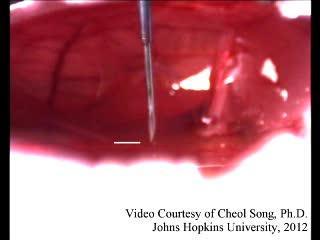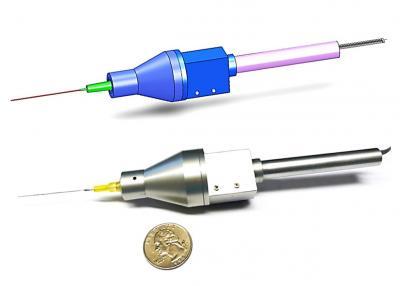Because this single fiber-optic cable is so small and flexible, the researchers could easily integrate it into the front of a tool used for eye surgery. By continually sending and receiving the near infrared laser beams, the high-speed fiber-optic sensor precisely measures the motion of the probe. This information then feeds to a computer that sends signals to small piezoelectric motors integrated into the surgical device to control the position of the tool tip. This creates a series of "station keeping" maneuvers that compensate for the surgeon's hand tremors.
Combined, the sensor and motors can operate accurately at 500 hertz (500 times each second), which is much higher than the typical tremor frequency of 0-15 hertz.
The researchers compared the effectiveness of the system by testing its ability to compensate for hand tremors during 5- and 30-second intervals. According to the researchers, these time periods were sufficient to determine the different characteristic between short- and long-term hand tremors. "A 30-second time period is enough to evaluate a surgeon's basic physiological hand tremor characteristics," said Song. For complete characterization, however, a record of a full surgical procedure, which typically lasts more than 3 hours, will be needed.
For their study, the tests were performed on two targets. The first was a dry "phantom," a material that has sufficient properties to stand as a proxy for medical research. A more real-world test was also done on a viable chicken embryo, which better simulated a realistic surgical environment because of the unpredictable movements of the live embryo.
During the next few years, the researchers hope to take their instrument from the laboratory to the operating suite, and with additional refinements expand its use to other fine-scale surgeries.
"The main objective of our research has been to make an established surgical tool 'smarter' by incorporating fiber-optic sensors and motion control to allow surgeons to maneuver the tool tip precisely and safely," said Jin U. Kang, another researcher with the Electrical and Computer Engineering department at Johns Hopkins. "SMART, which is capable of fine motion control and sensing, could significantly enhance the surgical performance of doctors and minimize surgical accidents."

This video shows how the SMART surgical tool is able to hold still by responding to unexpected movement from a surgical target (in this case, a chicken embryo). In the first part of the clip, the surgical tip of the SMART device has a good response to the unexpected embryo movement to keep a constant height. And then it is more stable at the latter part of the clip without the target's movement.
(Photo Credit: Courtesy Cheol Song, Johns Hopkins University.)

This shows the CAD model and prototype of the fiber-optic-sensor-based microsurgical tool, SMART.
(Photo Credit: Courtesy Cheol Song, Johns Hopkins University)
Source: Optical Society of America